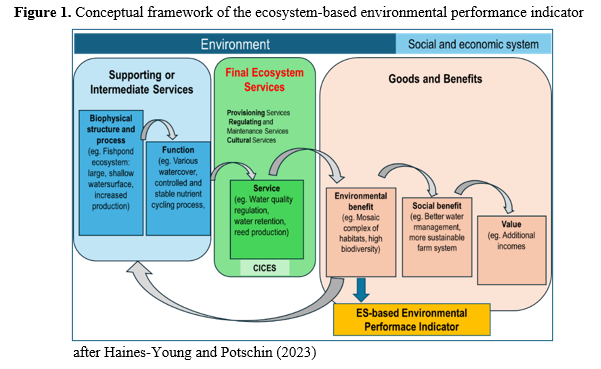DEVELOPMENT OF AN ECOSYSTEM SERVICE-BASED ENVIRONMENTAL PERFORMANCE INDICATOR FOR INLAND POND AQUACULTURE
Introduction
The general concept of sustainability and the components of sustainable development has now been well defined (FAO 1989). Sustainability is also one of the most important horizontal aspects of the European Green Deal’s priorities. It means such transition in farm systems that is better adapted to environmental conditions, minimises environmental footprints, and preserves natural values. Beyond the formulation of the sustainability goals, to determine the environmental performance of the production systems developing sustainability metrics became more and more urgent . The evaluation of the environmental interactions of aquaculture technologies is also a key component in enhancing sustainability, a principle that is well reflected in the EU aquaculture policies such as Aquaculture Strategic Guideline and Aquaculture Assistance Mechanism.
Filling this knowledge gap wide range of indicator-based evaluations were developed in the latest year ( FEAP 2022, Garlock et al. 2024 , EC 2024 , Nielsen et al. 2025). The aim of these assessments to measure performance of aquaculture production systems in the three key dimensions of sustainability: environmental, economic, community dimensions and comparing aquaculture management systems as well as evaluating the effectiveness of investment and reforms (Garlock et al. 2024).
Our analysis of the current indicators revealed that these methods basically focus for one-way industrial processes and not fully appropriate for evaluating circular production systems. Furthermore, when such circular systems are characterised using these indicators, the results are typically false and significantly lower than those obtained using a natural science-based approach (Knösche et al. 2004, Koushik et al 2020).
Conceptual framework
Pond farming in the EU concentrated in the Central Eastern European (CEE) region giving the vast majority of aquaculture production in these countries and being an important part of European agricultural heritage . The pond aquaculture sector produces yearly 80,000 tonnes of carp that is 26 percent of the total EU freshwater aquaculture production in volume and 260 million euros in value (EUMOFA, 2021). Pond farming applying circular approach is operated in a traditional, extensive production system. It is based on natural nutrient cycle and operates as an open ecological system, where natural and technological processes support each other (Halasi-Kovács 2022). It is a well-documented fact that extensive pond aquaculture provides a wide range of ecosystem services in addition to primary fish production (Willot et al. 2019, Palásti et al 2020, Sharma et al. 2024) .
A comprehensive assessment of these services has not been conducted yet, and there is an absence of specific environmental performance indicator based on the evaluation of these systems. As a first step in formulating our evaluation system, the concept of ecosystem services (Haines-Young 2023) can provide a natural theoretical framework. However, being developed an indicator, we were facing different long-standing problem: (1) the difficulty of the quantification of ecosystem services; (2) confusion of terms. So, we modified the conceptual framework of ES by adding a new benefit category, the ‘environmental benefit s’ that can well reflect the clear difference between the term of ecosystem service and environmental benefit. F urthermore, it provides an operational solution for developing ecosystem service -based environmental performance indicator that can be i ntegrated in Environmental Impact Assessment (EIA) and Life Cycle Assessment (LCA) studies of fishponds.
Next steps and results
In the next step, the ecosystem services provided by fishponds will be assessed. Subsequently, the environmental benefits resulting from these services will be determined and evaluated. Ecosystem service-based e nvironmental performance indicator will be developed and scaled based on the environmental benefits of pond aquaculture.
The results of this research provide a clear concept and definitions of the ecosystem service-based environmental performance indicator and can provide tools for the evidence-based environmental evaluation of different circular approached extensive, low-trophic aquaculture systems.
References
EC (2024) Implementing the Strategic Guidelines on EU Aquaculture. Climate-change Adaptation in the Aquaculture Sector. Comission Staff Working Document. Brussels, Pp. 43.
EUMOFA (2021) Freshwater aquaculture in the EU. Pp. 77.
FAO (1989) Sustainable development and natural resources management. FAO Conference 25. Session. Rome , 1989. C89/2 – Sup. 2.
FEAP (2022) Technical Screening Criteria for sustainable finfish aquaculture : input to the EU marketing standards , towards a sustainable food system and the EU taxonomy . Pp. 20.
Haines-Young, R. (2023) Common Interna onal Classifica on of Ecosystem Services (CICES) V5.2 and Guidance on the Applica on of the Revised Structure.
Halasi-Kovács, B. (2022) Role of freshwater pond aquaculture in maintaining the natural values of wetland habitats. HFA – MATE-HAKI. 28pp.
Garlock , T., Asche, F. et al. (2024). Environmental , economic , and social sustainability in aquaculture : the aquaculture performance indicators . Nature Communications. 15.
Knösche , R., Schreckenbach , K., Pfeifer , M. & Weissenbach , H. (2004) Balances of phosphorus and nitrogen in carp ponds. Fisheries Management and Ecology.
Koushik R, Vrba J, Koushik S and Mraz J. (2020) Nutrient footprint and ecosystem services of carp production in European fishponds in contrast to EU crop and livestock sectors Journal of Cleaner Production 270 (2020) 122268. DOI:10.1016/j.jclepro.2020.122268.
Nielsen, R., Guillen, J., et al. (2025) An analysis of the European aquaculture industry using the aquaculture performance indicators. Aquaculture Economics & Management, DOI: 10.1080/13657305.2025.2453747.
Palásti, P., Kiss, M., Gulyás, Á. & Kerepeczki , É. (2020) Expert Knowledge and Perceptions about the Ecosystem Services and Natural Values of Hungarian Fishpond Systems. Water, 12. 2144.
Sharma , P., Gyalog, G., et al. (2024) Reusability check-based refinement of a biophysical fishpond model . Computers and Electronics in Agriculture , Volume 218, 2024,108664, ISSN 0168-1699.
Willot , P-A., Aubin,J. , Salles , J-M., Wilfart,A. (2019) Ecosystem service framework and typology for an ecosystem approach to aquaculture , Aquaculture, Elsevier , Volume 512, 2019, 734260. ISSN 0044-8486. https://doi.org/10.1016/ j.aquaculture.2019.734260.
